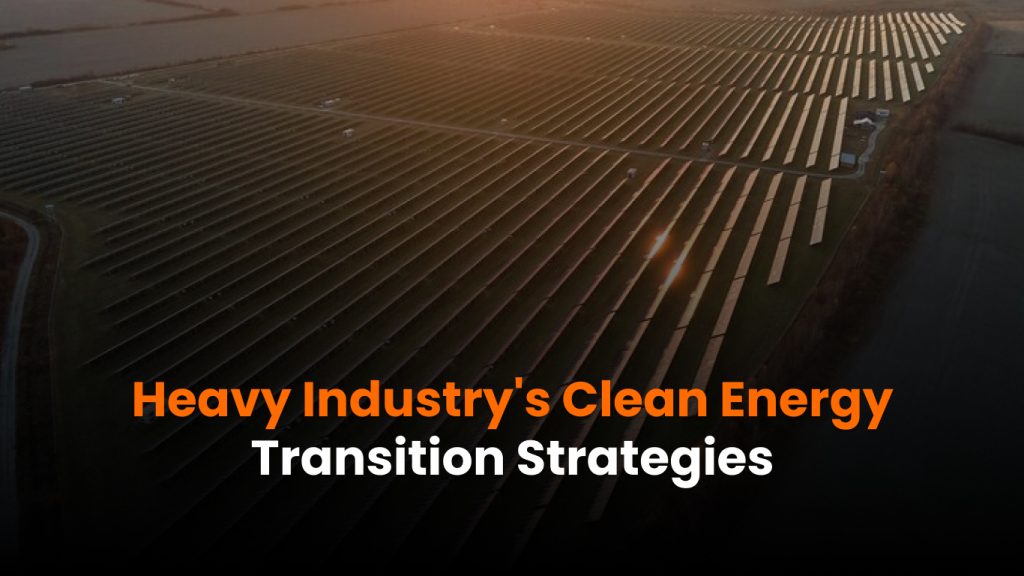Introduction
Heavy industry – including steel, cement, and chemicals – is responsible for a large share of global carbon emissions and is widely considered one of the toughest sectors to decarbonize. In fact, heavy industry accounts for roughly 22% of global greenhouse gas emissions. These industries rely on energy-intensive processes that often require extremely high temperatures (such as blast furnaces for steelmaking or kilns for cement) and frequently produce CO₂ as a byproduct of chemical reactions. This combination of high heat demand and process emissions makes it challenging to eliminate carbon output. Facilities like steel mills or cement plants also have very long lifespans and expensive capital equipment, which means changes happen slowly. Despite these hurdles, pressure is mounting for heavy industry to embark on a clean energy transition. Governments are enacting stricter emissions rules, investors are favoring greener operations, and customers are seeking low-carbon products. The encouraging news is that a number of strategies and emerging technologies can enable heavy industries to significantly cut their emissions while remaining productive.
Energy Efficiency and Material Optimization
The first step in decarbonizing heavy industry is improving efficiency and optimizing the use of materials. Energy efficiency measures can yield immediate benefits by reducing fuel consumption and waste. For example, industrial manufacturers are upgrading to more efficient machinery (motors, boilers, kilns) and implementing advanced control systems to optimize operations. In addition, maximizing material efficiency is key – for instance, increasing the use of recycled scrap metal in steel production or blending cement with alternative materials can reduce the energy required to produce each ton of product. By adopting best practices in process efficiency, some heavy industry companies have managed to curb emissions even as output grows. These improvements not only cut emissions but can lower operating costs, creating a strong business incentive to act. However, efficiency alone won’t achieve the deep emissions cuts required; it must be paired with cleaner energy sources and process innovations for a transformative impact.
Electrification and Renewable Power
One of the most promising avenues for heavy industry’s energy transition is electrification – using electricity (preferably from renewable sources) to drive processes that traditionally burned fossil fuels. Certain operations, like low- to medium-temperature heat generation, motors, and auxiliary systems, can be electrified with today’s technology. For instance, some mines now use battery-electric haul trucks and excavators instead of diesel, and there are pilot projects for electric arc furnaces to produce steel by melting scrap, which avoids the coal-intensive blast furnace route. Wherever heavy industrial processes can be powered by electricity, switching to renewable electricity immediately cuts those emissions.
Of course, not every high-heat process can be easily electrified with current technology. Manufacturing materials like primary steel or cement clinker requires sustained temperatures well above 1,000 °C, which is difficult to achieve economically with standard electric heaters. However, companies are exploring hybrid approaches – such as using electric pre-heating to supplement fossil fuels – and R&D is ongoing into breakthrough technologies like plasma heaters and ultra-high-temperature electrical systems. Meanwhile, increasing the use of clean electricity in heavy industry goes hand-in-hand with expanding renewable power generation. Many heavy facilities are now investing in on-site renewables or dedicated off-site renewable energy projects to supply their growing electric needs. This is an area where Sunhub can offer valuable support: heavy industrial sites can deploy solar arrays (for example, on large factory rooftops or adjacent land) and even wind turbines to self-generate some of their power. By working with Sunhub’s industrial solar solutions, companies can offset a portion of their electricity demand with reliable renewable energy, reducing both emissions and exposure to grid disruptions.
Green Hydrogen Fuel Switching
For many heavy industrial processes – especially those needing very high heat or involving chemical transformations – green hydrogen is emerging as a critical solution. Hydrogen can serve as a clean fuel to generate high temperatures or as a reactant to replace fossil hydrocarbons. When produced via electrolysis using renewable electricity, green hydrogen can be burned or used in processes without emitting CO₂ (the only combustion byproduct is water vapor). Several pioneering efforts are already underway: in steelmaking, companies are testing hydrogen to reduce iron ore (in place of coal-derived coke), aiming to produce “green steel.” In cement and glass production, hydrogen is being trialed as a kiln fuel to supplant natural gas. Heavy industry fuel switching to hydrogen could eliminate a large fraction of emissions that are otherwise very hard to abate with electrification alone.
Challenges remain – green hydrogen is currently more expensive than conventional fuels and requires new infrastructure for transport and storage. But as nations invest in hydrogen production and distribution, costs are expected to fall. Importantly, hydrogen retrofits of industrial equipment are becoming a focus: specialized hydrogen burners, turbines, and handling systems are being developed for deployment in existing plants. Over the next decade, using green hydrogen as a substitute for coal or gas can become increasingly feasible for heavy industries, dramatically cutting CO₂ output in sectors that have few other decarbonization options.
Carbon Capture and Storage
Even after maximizing efficiency, electrification, and hydrogen use, heavy industries may still emit CO₂ – either from remaining fossil fuel use or inherent chemical reactions (like CO₂ released from limestone in cement manufacturing). Carbon capture, utilization, and storage (CCUS) is therefore considered a necessary piece of the net-zero puzzle for heavy industry. CCUS entails capturing CO₂ from exhaust gases or process streams and then either reusing it or storing it permanently. For example, a cement plant can capture CO₂ from its kiln flue gases and inject that CO₂ into geological formations underground, preventing it from entering the atmosphere.
Deploying carbon capture at scale will likely be essential for heavy industry to reach climate targets. We’re beginning to see pilot projects: cement factories equipped with CO₂ capture units, steel plants planning to capture blast furnace emissions, and chemical facilities exploring carbon capture on large reformers. While adding CCUS is capital-intensive and can increase operating costs, it provides a way to deeply cut emissions without completely reinventing certain processes from scratch. In combination with the other strategies – efficiency, electrification, and hydrogen – carbon capture can neutralize the toughest remaining emissions. As carbon prices and emissions regulations strengthen, CCUS investments may also become more financially attractive for industrial players.
Conclusion
Heavy industry’s journey to a low-carbon future is just beginning, and it will require deploying all of the above strategies in tandem. By upgrading efficiency, electrifying processes where possible, switching to cleaner fuels like hydrogen, and capturing residual emissions, even the most emissions-intensive factories can substantially reduce their carbon footprint. Each strategy plays a role: efficiency and material optimization cut waste, electrification and renewables provide cleaner power, hydrogen replaces fossil fuels in furnaces, and carbon capture handles the rest. Collaboration with clean energy technology providers like Sunhub can accelerate this transition by equipping industrial sites with the solar power and storage solutions needed to run on low-carbon energy.
Decarbonizing heavy industry is undoubtedly a formidable challenge. Yet, with innovation and commitment, these sectors can reinvent themselves for the sustainable economy of the future. Every new electric arc furnace, hydrogen-fired burner, or on-site solar array brings heavy industry one step closer to aligning with global climate goals – ensuring we can continue to build and manufacture the products society needs, but with a fraction of the emissions of the past.




